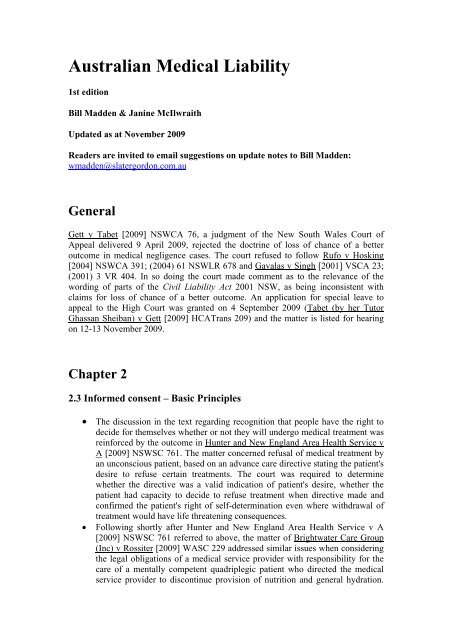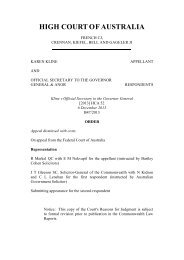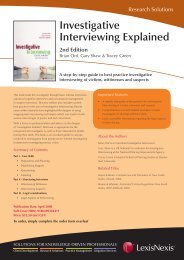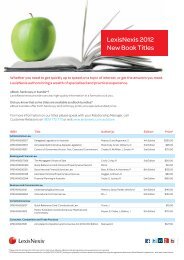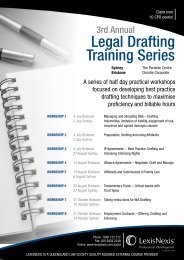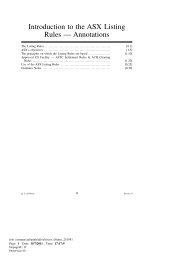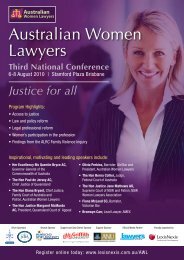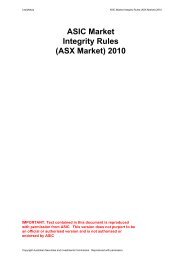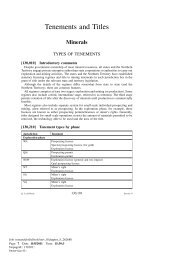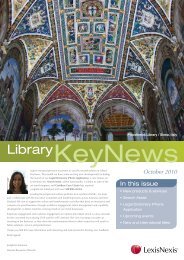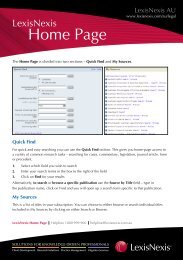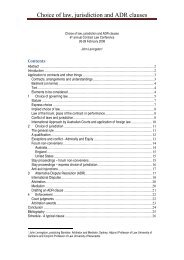Torts: Cases and Commentary - LexisNexis
Torts: Cases and Commentary - LexisNexis
Torts: Cases and Commentary - LexisNexis
You also want an ePaper? Increase the reach of your titles
YUMPU automatically turns print PDFs into web optimized ePapers that Google loves.
Australian Medical Liability1st editionBill Madden & Janine McIlwraithUpdated as at November 2009Readers are invited to email suggestions on update notes to Bill Madden:wmadden@slatergordon.com.auGeneralGett v Tabet [2009] NSWCA 76, a judgment of the New South Wales Court ofAppeal delivered 9 April 2009, rejected the doctrine of loss of chance of a betteroutcome in medical negligence cases. The court refused to follow Rufo v Hosking[2004] NSWCA 391; (2004) 61 NSWLR 678 <strong>and</strong> Gavalas v Singh [2001] VSCA 23;(2001) 3 VR 404. In so doing the court made comment as to the relevance of thewording of parts of the Civil Liability Act 2001 NSW, as being inconsistent withclaims for loss of chance of a better outcome. An application for special leave toappeal to the High Court was granted on 4 September 2009 (Tabet (by her TutorGhassan Sheiban) v Gett [2009] HCATrans 209) <strong>and</strong> the matter is listed for hearingon 12-13 November 2009.Chapter 22.3 Informed consent – Basic Principles• The discussion in the text regarding recognition that people have the right todecide for themselves whether or not they will undergo medical treatment wasreinforced by the outcome in Hunter <strong>and</strong> New Engl<strong>and</strong> Area Health Service vA [2009] NSWSC 761. The matter concerned refusal of medical treatment byan unconscious patient, based on an advance care directive stating the patient'sdesire to refuse certain treatments. The court was required to determinewhether the directive was a valid indication of patient's desire, whether thepatient had capacity to decide to refuse treatment when directive made <strong>and</strong>confirmed the patient's right of self-determination even where withdrawal oftreatment would have life threatening consequences.• Following shortly after Hunter <strong>and</strong> New Engl<strong>and</strong> Area Health Service v A[2009] NSWSC 761 referred to above, the matter of Brightwater Care Group(Inc) v Rossiter [2009] WASC 229 addressed similar issues when consideringthe legal obligations of a medical service provider with responsibility for thecare of a mentally competent quadriplegic patient who directed the medicalservice provider to discontinue provision of nutrition <strong>and</strong> general hydration.
The court’s reasons were consistent with the principle of patient autonomy orself-determination as to whether or not the patient will continue to receivemedical treatment. See also Australian Captial Territory v JT [2009] ACTSC105 which addressed consent to medical treatment in the context of thepatient’s wishes based on a delusional set of assumptions.2.6 The court as the ultimate arbiter• The discussion in the text regarding Rogers v Whitaker notes that the st<strong>and</strong>ardof care is not to be determined solely, or even primarily, by reference to thepractice followed or supported by a responsible body of opinion in theprofession. Marko v Falk [2008] NSWCA 293 at [76] – [79] briefly addressedthe circumstances in which a court may substitute its own opinion in thefollowing terms: ‘Mr Neil submitted that Rogers v Whitaker supported theproposition that if all members of a particular profession were doingsomething that was not in accordance with what the Court considered to becareful practice, then the Court should say so. That submission was pitched atsuch a high level of generality as to be meaningless. It fails to recognise thecareful distinction all members of the High Court drew in Rogers v Whitakerbetween diagnosis <strong>and</strong> treatment, <strong>and</strong> warning of risks. Mr Neil did notsuggest any sensible route by which the Court could impose a view as tocareful practice contrary to the medical opinions called on both parties’behalves. Mr Neil could not refer the Court to any case since (or before)Rogers v Whitaker in which the court had taken the course he propounded in acase which involved clinical judgment in an operational context……In myview this was a case where the plurality view in Rogers v Whitaker as to theoften decisive role professional opinion may play has strong resonance.’Chapter 33.9 Duty under statute• In the context of possible claims against medical practitioners under the TradePractices Act 1974 (Cth), see Kowalczuk v Accom Finance [2008] NSWCA343. The court followed Shahid v Australian College of Dermatologists [2008]FCAFC 72; (2008) 168 FCR 46.3.24 Qualifications <strong>and</strong> experience• Imbree v McNeilly [2008] HCA 4. Consideration of aspects of Cook v Cook;Duty of care in the context of special relationship between plaintiff <strong>and</strong>defendant.
Chapter 44.1 Duties to third parties• Glennie v Glennie [2009] NSWSC 154. As noted in the text, in Sullivan vMoody [2001] HCA 59; (2001) 207 CLR 562 the High Court consideredwhether medical practitioners, social workers <strong>and</strong> departmental officersinvolved in investigating <strong>and</strong> reporting upon allegations of child sexual abuseowed a duty of care to suspects. The court concluded that no such dutyexisted. Glennie v Glennie is an interlocutory decision addressing only alimitation period extension, but it foreshadows a claim against a medicalpractitioner by a sexual assault victim. It is alleged that the medicalpractitioner failed in his statutory duty to report sexual abuse of which he wasaware, thereby allowing it to continue such that the victim suffered furtherdamage.• Chahoud v Koleda [2008] NSWSC 1060; (2007-2008) 72 NSWLR 740. Amedical practitioner has no duty to a beneficiary of the will of a deceasedpatient in relation to advice to a court regarding the deceased’s capacity <strong>and</strong>has the benefit of witness immunity for the contents of letters provided to acourt or legal practitioner on the capacity of a deceased patient to execute awill.4.2 Claims by a child arising from earlier breach of duty to mother• Paxton v. Ramji 2008 ONCA 697. Consideration of whether duty owed tofuture child, in circumstances where a doctor prescribed anti acne medicationAccutane (which carries the risk of causing fetal malformation) to a youngwoman, knowing that her partner had undergone vasectomy. (Of doubtfulapplication in Australia <strong>and</strong> in any event see Liebig v. Guelph GeneralHospital 2009 CanLII 56297.)4.8 Psychiatric patients causing loss or injury to others• Gray v Thames Trains & Ors [2009] UKHL 33. Man, suffering post traumaticstress disorder from earlier incident, not able to recover compensation forconsequences of his later knife killing of a drunken pedestrian. Illegalitydefence.• Simon <strong>and</strong> Anor v Hunter <strong>and</strong> New Engl<strong>and</strong> Area Health Service [2009]NSWSC 758 is an interlocutory decision only (regarding the availability of ajury trial) but arises from a claim in that a psychiatric patient was releasedfrom hospital into care of friend for road journey from Taree to Victoria <strong>and</strong>the patient killed the friend during the journey. The claim will be one byrelatives of the deceased for damages against Area Health Service.• The Quadriplegic Centre Board of Management v McMurtrie [2009] WASCA173. A decision considering the duty of an institution to warn staff of the riskof injury from a patient with a history of violence. The claim failed oncausation grounds.
4.20 Normative causation• Adams by her next friend O'Grady v State of New South Wales [2008]NSWSC 1257. Alleged breach of duty by State in providing plaintiff withaccess to knife with which she stabbed <strong>and</strong> killed a teacher. As to causationsee [113]ff.Chapter 55.19 Ethical framework• Incidental to the discussion regarding duty to disclose error are recent movestowards a statutory framework for ‘m<strong>and</strong>atory reporting’. For example,Section 71A of the Medical Practice Act 1992 (NSW) introduced a concept of“reportable misconduct”, placing an obligation on doctors (after 1 October2008) to report certain types of misconduct to the New South Wales MedicalBoard.o71A Reportable misconduct: (1) A registered medical practitionercommits reportable misconduct in the following circumstances: (a) ifhe or she practises medicine while intoxicated by drugs (whetherlawfully or unlawfully administered) or alcohol, (b) if he or shepractises medicine in a manner that constitutes a flagrant departurefrom accepted st<strong>and</strong>ards of professional practice or competence <strong>and</strong>risks harm to some other person, (c) if he or she engages in sexualmisconduct in connection with the practice of medicine. (2) Aregistered medical practitioner who believes, or ought reasonably tobelieve, that some other registered medical practitioner has committedreportable misconduct must, as soon as practicable, report the conductto the Board.• Guidelines issued in August 2008 by the New South Wales Medical Boardprovide some commentary on subsection (b), indicating that the Boardconsiders a flagrant departure from accepted st<strong>and</strong>ards involves a very highdegree of departure from such st<strong>and</strong>ards. Conduct which is merely careless ornegligent (in the sense that it fails to meet the st<strong>and</strong>ards of care owed topatients) will generally not be flagrant. Whilst it is possible for reasonablepractitioners to disagree about whether a particular practice is or is notnegligent, a flagrant departure is likely to be one which is both serious <strong>and</strong>obvious to any reasonable practitioner. This is particularly likely to be the casewhere another practitioner engages in reckless, unethical, wilful or criminalbehaviour. The reportable misconduct must pose a risk of harm to some otherperson as well as constituting a flagrant departure from accepted st<strong>and</strong>ards ofprofessional practice or competence, before m<strong>and</strong>atory reporting is required.The Guideline can be found on the New South Wales Medical Board websitehttp://www.nswmb.org.au under the menu item ‘news & updates’.• Similar legislation appears now in Queensl<strong>and</strong>.
• Similar ethical obligations are reflected in 6.3.4 <strong>and</strong> 6.3.5 of Good MedicalPractice: A Code of Conduct for Doctors in Australia which will be consideredfor adoption or endorsement by the State <strong>and</strong> Territory medical boards <strong>and</strong>that the new Medical Board of Australia will adopt the Code.http://goodmedicalpractice.org.au/wp-content/downloads/Final%20Code.pdfChapter 66.1 Non-Delegable duties – Introduction• Transfield Services (Australia) v Hall; Hall v QBE Insurance (Australia)[2008] NSWCA 294. A non-medical decision which in part discusses whetherthere is a general doctrine in Australian law that a person has a non-delegableduty to ensure reasonable care taken by an independent contractor employedto engage in an extra-hazardous or inherently dangerous activity; whetherthere is scope for extending concept of non-delegable duties beyond existingcategories <strong>and</strong> the relevance of factors of control <strong>and</strong> vulnerability to findingof non-delegable duty.Chapter 77.16 Elective procedures• Ormsby v Stewart & Ors [2009] QSC 200. Intraocular lens replacementsurgery. Breach of duty & causation not found.7.20 Clinically indicated procedures• Rooke v Minister for Health [2009] WASCA 27 on appeal from Rooke vMinister for Health [2008] WADC 6. Post-operative sensitivity - Dupuytren'scontracture. Breach of duty & causation not found.7.32 Breach of duty in informed consent cases – differing riskselsewhere• G & C v Down [2008] SADC 135. A decision concerning failure to warn ofthe risks of failure of a sterilisation procedure. At [140] ff the court addressesdifferences between a surgeon's own rate <strong>and</strong> the general published failure
ate. ‘[140] In my opinion, the Defendant failed to meet the st<strong>and</strong>ardrequired of him in that he did not make it clear that the numerical ratio of 1 in2000 related to his experience. Using the st<strong>and</strong>ard of an ordinary skilledgynaecologist, such a practitioner would have made it clear. In my view,where the gynaecologist’s personal experience is conveyed in numericalterms, it is important that it be made clear to the patient that it refers thegynaecologist’s failure rate. The personal experience of the gynaecologistwould be of great significance to the patient. [141] I am also of the opinionthat where the numerical ratio of the gynaecologist’s personal failure rate isconveyed, either in response to questioning by the patient or being volunteeredby the gynaecologist, then in order to provide a proper balance for the patient,the literature failure rate should be conveyed. The picture would not becomplete otherwise.’• On appeal as to causation see G, P A & C, P v Down [2009] SASC 217, whereat [67] Anderson J did not disagree with the approach of the trial judgeregarding breach of duty.Chapter 88.10 The ‘widely accepted’ defence• Sydney South West Area Health Service v Stamoulis [2009] NSWCA 153.The evidence of an expert is not inadmissible merely because he or she ismaterially interested in the proceedings. Such matters go to weight <strong>and</strong> notadmissibility.• Hawes v Holley [2008] NSWDC 147. Consideration of alleged failure to treatpatient by pharmacological means to avoid need for abdominal surgery, incircumstances where complications of the abdominal surgery later occurred.• Vella v Permanent Mortgages Pty Ltd [2008] NSWSC 505. Consideration ofregional variations in widely accepted practice: see [550] ff.• Melchior <strong>and</strong> Ors v Sydney Adventist Hospital Ltd <strong>and</strong> Anor [2008] NSWSC1282. Negligence at common law not found, but in any event ‘widelyaccepted’ defence capable of application: see [142] ff.• MD v Sydney South West Area Health Service [2009] NSWDC 22 held thatthe ‘widely accepted’ defence must be pleaded (in NSW) for a defendant torely on the defence at trial.• Kocev v Toh [2009] NSWDC 169. Chiropractic treatment. Negligence atcommon law not found , but in any event ‘widely accepted’ defence capable ofapplication: see [80].Note: Mark Williams, DLA Phillips Fox, suggests that whilst South Australia’sprovision is similar to that of New South Wales, the other jurisdictions have asubtle but significant wording difference which may give rise to a differentapproach to that taken in New South Wales. See M Williams, Proving medicalnegligence across Australia, DLA Phillips Fox Health Law Bulletin May 2009.
8.34 Delayed diagnosis & misdiagnosis• Spasovic v Sydney Adventist Hospital [2003] NSWSC 791. Claim alleging toexercise reasonable care in assessing <strong>and</strong> treating complaints made <strong>and</strong>symptoms exhibited in particular a headache, which were caused by a smallcerebral haemorrhage from an arterio-venous malformation (AVM”).Discharge from hospital without the small cerebral haemorrhage or the AVMhaving been diagnosed.• Davy -v- Minister for Health [2009] WASCA 170. Claim failed, allegingdelayed arrangement for knee infection review by hospital.8.62 ff Surgical errors• Wells v Juengling [2008] WADC 18 was overturned on appeal (pendingretrial) in Juengling v Wells [2009] WASCA 125.• Marko v Falk [2007] NSWSC 14 has now been considered by the New SouthWales Court of Appeal as Marko v Falk [2008] NSWCA 293.8.74 Failure to follow up• Young v CAACI & Ors [2008] NTSC 47. CAACI had a responsibility to putadministrative procedures in place to deal with patients who fail to attendappointments relating to potentially serious conditions, in this case beingsuspected ischaemic heart disease. As there was no system implemented at thetime, breach of duty on the part of CAACI. See below for comment regardingcontributory negligence.8.76 Mental health care• Adams by her next friend O'Grady v State of New South Wales [2008]NSWSC 1257. Alleged breach of duty by State in providing plaintiff withaccess to knife with which she stabbed <strong>and</strong> killed a teacher.8.116 Birth trauma - Foetal• Boustead v North West Strategic Health Authority [2008] EWHC B11 (QB).Claim in relation to care provided by a young mother during her pregnancy<strong>and</strong> labour <strong>and</strong> to her baby during the neonatal period. The child subsequently
suffered from cerebral palsy with moderate learning disability, dysarthria <strong>and</strong>right sided hemiplegia. Experts agreed that the child suffered brain injury dueto an intraventricular haemorrhage <strong>and</strong> the serious consequences which flowedfrom it.• Do (an infant) by his next best friend Lan Thi Hoang & Anor -v- King EdwardMemorial & Princess Margaret Hospitals Board [2008] WADC 118. Claim inrelation to whether the plaintiff (before birth) was adequately monitored <strong>and</strong>whether intrauterine resuscitation <strong>and</strong>/or earlier delivery ought to haveoccurred; causation as to whether alleged negligence lead to prolongation ofhypoxic event <strong>and</strong> caused or contributed to injury in the form of cerebral palsyof infant plaintiff.8.126 Birth trauma - Maternal• Hassan v The Minister for Health [No 2] [2008] WASCA 149. Claim arisingfrom induced labour following foetal death in utero. Issues includedconsideration of whether informed consent was given to participate in a trial ofuse of a drug Misoprostal to induce labour <strong>and</strong> the adequacy of managementof the induction of labour, leading to hysterectomy.• Sernack v Leader NSW District Court unreported, 23 April 2008. 2005/5676per McLoughlin DCJ. Claim concerning injury/laceration to the rectal mucosa,internal anal sphincter <strong>and</strong> external anal sphincter, leading to recto-vaginalfistula.8.143 Dental care• R v Pegios [2008] NSWDC 104. An unusual matter involving prosecution of adentist for the manslaughter of a patient, arising from the administration ofsedatives.Chapter 99.12 Wednesbury unreasonableness• Precision Products (NSW) Pty Limited v Hawkesbury City Council [2008]NSWCA 278. A non-medical case which in part considered section 43A CivilLiability Act 2002 NSW <strong>and</strong> at [175] ff: ‘A further important consideration isthe content of sub-s 43A(3) <strong>and</strong> the meaning of the phrase “so unreasonablethat no authority having the functions of the authority in question couldproperly consider the act or omission to be a reasonable exercise of itsfunction.” Such wording can be seen to have its source in what is oftenreferred to as “Wednesbury unreasonableness” from Associated ProvincialPicture Houses Limited v Wednesbury Corporation [1948] 1 KB 223 at 229-230. Regard could equally be had to the formulation of cognate concepts inAvon Downs Pty Limited v Federal Commission of Taxation [1949] HCA 26;78 CLR 353 at 360; R v Connell; ex parte Hetton Bellbird Collieries Limited[1944] HCA 42; 69 CLR 407 at 430; <strong>and</strong> Buck v Bavone [1976] HCA 24; 135
CLR 110 at 118-119. Cognate ideas are also found in the law attending theresponsibility of company directors. The Court there focuses on whetherdecisions made by boards are made honestly in the interest of the company orare of a kind which no reasonable person could have reached: seeShuttleworth v Cox Brothers <strong>and</strong> Co (Maidenhead) Limited [1927] 2 KB 9 at23-24; Peters’ American Delicacy Co Ltd v Heath [1939] HCA 2; 61 CLR 457at 481; <strong>and</strong> Wayde v New South Wales Rugby League Limited [1985] HCA68; 180 CLR 459 at 469-470. While these are different areas of humanendeavour, formulations of the kind used in these cases, whether it be inpublic law, the law of business or the law of torts are attempts to formulatemore attenuated tests for legitimate activity than by reference to a fixedst<strong>and</strong>ard of reasonable care. Whether it is appropriate to describe s 43A asencapsulating the blunt expression of “gross negligence” is a matter fordebate. However, it is plain that the drafter of s 43A was attempting toameliorate the rigours of the law of negligence. …...’9.18 Apologies• Dovuro Pty Ltd v Wilkins [2003] HCA 51; 215 CLR 317. Consideration ofthe extent to which a court may interpret an apology or admission asdetermining liability or assisting in a determination of liability.9.21 Duty to rescue• R v Natalie Burns [2009] NSWDC 232. Consideration of an unusualcircumstance under the criminal law, in which a duty to rescue may exist. Seeat [31]:o ‘Notwithst<strong>and</strong>ing the restraint which courts exercise in this area of thelaw, I am satisfied that while it is necessary for me to avoid engagingin judicial legislation by asserting a general principle analogous tosection 155 of the Northern Territory Criminal Code Act, nonethelesson the facts in the present case I am satisfied that I can <strong>and</strong> should statethe law of New South Wales to be as follows: “If a person voluntarilyinvites or permits potential recipients to attend his or her home for thepurpose of a prohibited drug supply transaction where the drugs are tobe consumed on the premises, <strong>and</strong> where such a recipient may be orbecome seriously affected by drugs to the point where his or her lifemay be endangered, the drug supplier has a duty to conduct himselftoward the drug recipient without being grossly or criminallyneglectful.” ‘Chapter 1010.15 <strong>Cases</strong> regarding the exclusion of the plaintiff’s evidence• Neal v Ambulance Service of New South Wales [2008] NSWCA 346: Seediscussion at [40] – [42] regarding the practical effect of the exclusion:
“Whatever the real purpose of the provision, the issue for determination ishow a court is now to identify what course the plaintiff would have taken,absent negligence. That assessment might include evidence of the following:(a) conduct of the plaintiff at or about the relevant time; (b) evidence of theplaintiff as to how he or she might have felt about particular matters; (c)evidence of others in a position to assess the conduct of the plaintiff <strong>and</strong> his orher apparent feelings or motivations, <strong>and</strong> (d) other matters which might haveinfluenced the plaintiff….Properly understood, the prohibition on evidencefrom the plaintiff about what he or she would have done is of quite limitedscope. Thus, the plaintiff cannot say, “If I had been taken to hospital I wouldhave agreed to medical assessment <strong>and</strong> treatment”. Indeed, as the NegligenceReview recognised, such evidence would be largely worthless. However, theplaintiff might have explained such evidence along the following lines: “Irecall on the trip to the police station that I began to fell less well; my state ofinebriation was also diminishing; I began to worry about the pain in my head….”…. That evidence (entirely hypothetical in the present case) would not beinadmissible. If accepted, it might provide a powerful reason for discountingany inference as to future conduct drawn from the past refusal of treatment. Itwould constitute evidence as to the plaintiff’s position, beliefs <strong>and</strong> fears.Because an inference would need to be drawn from that evidence, no doubt thecourt would take into account the likely response of a reasonable person insuch circumstances. That is consistent with the Act requiring that the matterbe determined “subjectively in the light of all relevant circumstances”.10.20 Other case examples• Hookey V Paterno [2009] VSCA 48: Orthognathic surgery for correction ofClass II malocclusion in 49 year old female smoker. Duty to warn of risk ofadverse effect of proposed surgery & causation issue — whether patient wouldhave undergone surgery if warned of risk.• Kerr v Minister for Health [2007] WADC 61 has now been considered by theWestern Australian Court of Appeal as Kerr v Minister for Health [2009]WASCA 32 ; appeal dismissed.• Watson -v- Kailis [2008] WADC 95. Alleged failure to warn of risk ofcosmetic procedures <strong>and</strong> post-operative complications. Trichloroacetic acidpeel of the face ("TCA peel").• Hansen -v- Babich [2006] WADC 189. Scarring to back - Whether necessaryto warn of increased risk of scarring in the event of infection.• Marko v Falk [2007] NSWSC 14 has now been considered by the New SouthWales Court of Appeal as Marko v Falk [2008] NSWCA 293.Chapter 11Amaca Pty Limited v Ellis [2009] HCATrans 077 records the granting of anapplication for special leave to appeal. It appears that the High Court at trial willaddress ‘evidential gap’ cases. The applicant described the issue on appeal as ‘does aclaimant need to prove more than an act or omission increased the risk of an injury
occurring? Can proof of an increase in risk be enough, even though the increase ofrisk did not cause the injury.’11.10 Causation principle legislation• Den Elzen v Harris [2008] WADC 106. Claim concerning management ofhydrocephalus <strong>and</strong> whether outcome would have differed in any event. Note at[203]: “However, this is in my view a case where the damage would be thevery sort of thing that would be likely to occur in the event of breach, so thatan evidentiary onus would fall on the defendant to show an absence ofcausation.”• Queen Elizabeth Hospital v Curtis [2008] SASC 344. Although not expresslyaddressing the provisions which provide that in determining liability fornegligence the plaintiff always bears the onus of proving on the balance ofprobabilities, any fact relevant to the issue of causation, see detaileddiscussion of causation after the observations of Gaudron J in Bennett vMinister of Community Welfare.11.10 Causation – common law principles• In the text at 11.11, the authors said It may be sufficient to establish causationthat a defendant’s breaches of duty materially increased the risk of injury tothe plaintiff, <strong>and</strong> that risk materialised: see Flounders v Millar [2007]NSWCA 238, but contrast the remarks of Kieffel J in Roads <strong>and</strong> TrafficAuthority v Royal [2008] HCA 19 at [144]. However in Sydney South WestArea Health Service v Stamoulis [2009] NSWCA 153 per Ipp JA (Beazley <strong>and</strong>Giles JJA agreeing) the court held that a mere material increase in the risk ofinjury followed by the eventuation of the risk in question is insufficient toestablish causation. The plaintiff must establish that it was probable that therisk created by the tortfeasor came home.11.21 Causation – Medical liability case examples• Den Elzen v Harris [2008] WADC 106. Claim concerning management ofhydrocephalus <strong>and</strong> whether outcome would have differed in any event. Note at[203]: “However, this is in my view a case where the damage would be thevery sort of thing that would be likely to occur in the event of breach, so thatan evidentiary onus would fall on the defendant to show an absence ofcausation.”• Christou v Minister for Health [2008] WASCA 214. Appeal from decisionconcerning intestinal perforation during course of total abdominalhysterectomy surgery.Chapter 12Chapter 12 Loss of chance – the aftermath
Gett v Tabet [2009] NSWCA 76, a judgment of the New South Wales Court ofAppeal delivered 9 April 2009, rejected the doctrine of loss of chance of a betteroutcome in medical negligence cases. The court refused to follow Rufo v Hosking[2004] NSWCA 391; (2004) 61 NSWLR 678 <strong>and</strong> Gavalas v Singh [2001] VSCA 23;(2001) 3 VR 404. In so doing the court made comment as to the relevance of thewording of parts of the Civil Liability Act 2001 NSW, as being inconsistent withclaims for loss of chance of a better outcome. An application for special leave toappeal to the High Court was granted on 4 September 2009 (Tabet (by her TutorGhassan Sheiban) v Gett [2009] HCATrans 209) <strong>and</strong> the matter is listed for hearingon 12-13 November 2009.[Reference to the following notes should be qualified by consideration of Gett vTabet [2009] NSWCA 76 above.]• O'Gorman v Sydney South West Area Health Service [2008] NSWSC 1127.Consideration of content of duty of care owed by breast screening organisationto plaintiff; evidence supported the application of the causation principlestated by McHugh J in Chappel v Hart. This was not a case wheremetastasisation was likely in any event <strong>and</strong> the plaintiff had merely lost thechance of a better outcome. The events which occurred, i.e. the developmentof tumours in the plaintiff’s lungs <strong>and</strong> brain, occurred within the very area ofrisk which had been increased by the delay in diagnosis. No scope for theapplication of the principle in Rufo v Hosking. See [150] – [151]. On appeal asSydney South West Area Health Service v Stamoulis [2009] NSWCA 153, thematter was sent for retrial on the issue of breach of duty, by reason of the trialjudge’s exclusion of certain evidence.• State of New South Wales v Burton [2008] NSWCA 319. Difficulties ofassessment of loss of chance, chance of some better outcome highlyspeculative. At [110], although the onus is on the plaintiff to identify the valueof the lost chance, in accordance with the authorities referred to above, it isreasonable to err on the side of generosity, to avoid the negligent defendantobtaining too great a benefit of the doubt from uncertainty as to the causes <strong>and</strong>treatment of psychiatric conditions.Chapter 1313.10 100% reduction for contributory negligence• Adams by her next friend O'Grady v State of New South Wales [2008]NSWSC 1257. Alleged breach of duty by State in providing plaintiff withaccess to knife with which she stabbed <strong>and</strong> killed a teacher. As to contributorynegligence: see [132] ff. “…in assessing relative culpability <strong>and</strong> respectiveshare in the responsibility, the Court is entitled to come to a view that thecontributory negligence should be assessed at 100% of the cause of the injury.For the reasons already given as to responsibility for the stabbing, duty of
care, damages <strong>and</strong> causation, I would ordinarily assess the “contributorynegligence” to be at 100% of the damage…”• Zilio v Lane [2009] NSWDC 226 discloses a 100% reduction for contributorynegligence as an alternative finding in a motor accident context, withoutreferring to the applicable civil liability legislation provision.13.18 Medical liability cases regarding contributory negligence• G & M v Sydney Robert Armellin [2008] ACTSC 68. Claim concerning IVFprocedure alleging breach of duty of care in transferring two embryos whenonly one embryo requested. Inherent risk of multiple birth in IVF procedure.Contributory negligence by failing to communicate, advise, or nominate to thestaff at the fertility centre the number of embryos to be transferred. Notionalreduction of 35% had the claim succeeded: see [121] ff.o Note: This decision was reversed on appeal G & M v Armellin [2009]ACTCA 6. The Court of Appeal held that the failure of the respondentto confirm the number of embryos for transfer with fertility centre staffwas a breach of his duty of care to the appellants.• Young v CAACI & Ors [2008] NTSC 47. Contribution to any loss or damageby failing to keep appointments at the clinic, failing to follow up with thedoctors <strong>and</strong> failing to inform doctors of these tests at his subsequentattendances at for various unrelated ailments. Defendant's liability reduced by50%.Chapter 1414.1 Wrongful birth claims• G & M v Sydney Robert Armellin [2008] ACTSC 68. Claim concerning IVFprocedure alleging breach of duty of care in transferring two embryos whenonly one embryo requested. Inherent risk of multiple birth in IVF procedure.Causation in the context of failure to terminate one pregnancy or to releasechild for adoption.o Note: This decision was reversed on appeal G & M v Armellin [2009]ACTCA 6. The Court of Appeal held that the failure of the respondentto confirm the number of embryos for transfer with fertility centre staffwas a breach of his duty of care to the appellants.• For a helpful discussion on issues in wrongful birth claims, see C Lake, Thekid <strong>and</strong> the cash: Categorising damage in wrongful birth <strong>and</strong> wrongfulpregnancy, (2009) 17 TLJ 55.Chapter 1515.19 Intentional torts in medical cases
• Dragica Ljubic v Sydney Robert Armellin [2009] ACTSC 21. Finding oftrespass in that the defendant did not have the consent of the plaintiff toremove her ovaries in the context of a hysterectomy.• Kent -v- Edwards [2009] WADC 5. Plaintiff alleged trespass in the context ofbiopsy. Trespass not found.• Lee v Fairbrother [2009] NSWDC 192. Sexual relationship between generalpractitioner <strong>and</strong> patient gave rise to award of damages for breach of duty, notassault: see [42] – [43]. However, Civil Liability Act 2002 (NSW) did notapply by reason of the ‘other sexual misconduct’ aspect of the exclusion insection 3B(1)(a).15.21 Intentional torts in medical cases• Breslin & Ors v McKenna & Ors (Omagh Bombing case) [2009] NIQB 50.Comment at [272] to the effect that where the defendant’s liability is fortrespass to the person, issues of remoteness of damage do not arise: ‘….Since Ihave concluded that the liability of the defendants is based upon trespass, anintentional tort, I do not consider that any issue of remoteness arises (seeWainwright v Home Office [2004] 2 AC 406 <strong>and</strong> Clerk <strong>and</strong> Lindsell 19thedition paragraph 2-110). I do not intend to rehearse the detail of the medicalreports or the accounts given to me of the enormous difficulties a number ofthose involved had in coping with the consequences of this bomb. For manythe effects are catastrophic <strong>and</strong> their lives will never be the same.’


